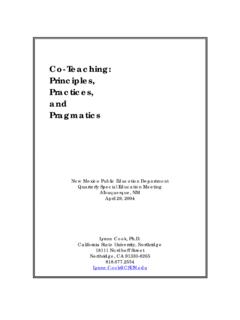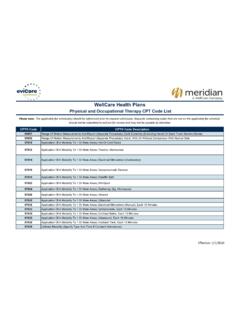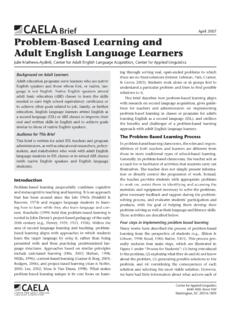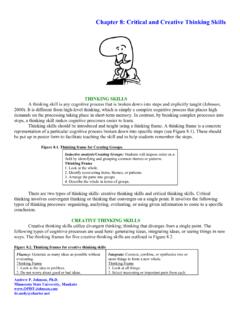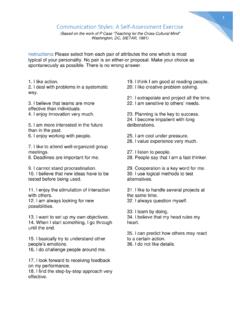Transcription of Transfer of Learning and Teaching: A Review of Transfer ...
1 Transfer of Learning and Teaching: A Review of Transfer Theories and Effective Instructional Practices Shiva Hajian Simon Fraser University, Canada IAFOR Journal of EducationVolume 7 Issue 1 Summer 201993 Abstract One of the primary goals of education is to ensure that learners can apply their acquired knowledge in various ways and under different circumstances. However, this expected Transfer does not always occur and, therefore, the acquired knowledge cannot be flexibly employed in different contexts.
2 One way to minimize this problem is to understand how Transfer occurs and what Learning conditions can improve this process. This Review paper provides major theoretical perspectives and pedagogical practices to explore the most effective ways to optimize knowledge acquisition and Transfer . The results of the comparison of the selected theories indicated that Transfer was a multi-dimensional process that could occur at any stage of Learning and could be enhanced through coaching, scaffolding, interacting, assessing and reflecting in situated Learning environments.
3 Keywords: Transfer of Learning and teaching, situated Learning IAFOR Journal of EducationVolume 7 Issue 1 Summer 201994 Many researchers have defined Transfer as the productive application of prior Learning and experiences in novel contexts (Gass & Selinker, 1983; Gick & Holyoak, 1987; Roediger, 2007). While the definition of a novel context may initially appear ambiguous, most Transfer studies consider a novel context as a situation that is potentially different from the original situation in which Learning has already taken place (McDaniel, 2007).
4 Thus, applying knowledge to a different domain, aligning it with a new goal and being assessed differently, can all be considered as novel contexts (Barnett & Ceci, 2002; Pan & Richard, 2018). A large body of research indicates that students often find transferring knowledge to situations other than the one in which it was learned highly challenging (Gilbert et al., 2011). Therefore, many educators and researchers have attempted to identify the factors that influence later acquisition of knowledge by examining the cognitive and metacognitive processes that occur during the Learning process.
5 The result has been a vast amount of literature with various perspectives towards Learning and instructional practices along with large variability among findings (Blume, Ford, Baldwin, & Huang, 2010). Therefore, the goal of this article is to Review some of these theories to identify the consistent factors that facilitate knowledge Transfer and provide examples of the instructional strategies that can provide optimal opportunities for learners to apply their acquired knowledge and expertise.
6 Since discussing all theories from Transfer literature is beyond the scope of this Review , only a few traditional and contemporary theoretical perspectives will be provided and discussed. These theories begin with the traditional cognitive theories of Transfer and end with more contemporary Learning Transfer theories. However, the selected instructional practices will predominantly be based on social constructivist approaches to Learning such as situated Learning theory.
7 The reason for this choice is the extensive employment of contextual and inquiry Learning methods in science and technology research and the presence of empirical evidence for successful application of these methods (Aparicio-Ting, Slater, & Kurz, 2019; Potvin, Hasni, & Sye, 2017). At the end, some of the advantages and disadvantages of the stated theories will be discussed and several pedagogical suggestions will be provided. Theoretical Models of Transfer Theory of Identical Elements Learning Transfer has become a significant research topic in educational psychology since Thorndike and Woodworth developed the theory of identical elements in 1901 (Schunk, 2004; Singley & Anderson, 1989).
8 According to this theory, Learning can be transferred from one activity to another ( , training to performance) if the two activities are highly similar and share many common elements. The level of Transfer is also determined by the level of similarity between the original context of the training and the target context of the performance. Thorndike conducted a study on 8,564 high school students and noticed that the art and science courses taken by the students had very little effect on their problem - solving skills.
9 For example, subjects such as math, physics, chemistry, Latin and French had very little effect on strategic thinking and problem - solving skills. While the challenging practices of Learning sciences had helped students develop general Learning skills and intellectual abilities, it had not helped them develop efficient problem - solving abilities required to tackle real life problems. He therefore emphasized the significance of the relationship between the content taught in school and the demands of real-life skills.
10 Identical elements theory challenged the traditional view of teacher-centered pedagogy and became one of the pioneers of active Learning theories. This view of Learning was followed by Dewey s pragmatic view of Learning and his idea of inquiry Learning classrooms. According to this IAFOR Journal of EducationVolume 7 Issue 1 Summer 201995view, classrooms need to represent real life situations and provide opportunities for students to flexibly participate in distinct Learning activities and in distinct social contexts (Dewey, 1938; Gutek, 2014; Williams, 2017).











